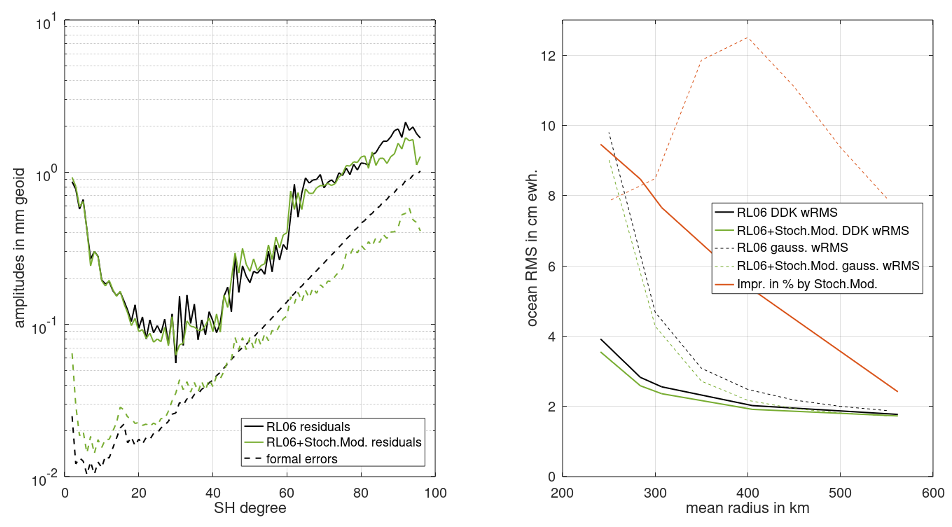
IP4: Optimized Space-Time Parameterization for GRACE and GRACE-FO Data Analysis (OSTPAGA)
PIs: Roland Pail (TUM), Frank Flechtner (TUB)
Research Objectives
- Analyse systematic and stochastic instrument errors & derive stochastic models
- Optimize parameter models to describe spatio-temporal signals
- Adequate treatment of background model errors
- Numerical study of individual ingredients and their interplay, quantification of gain w.r.t. classical processing schemes
- Quantify gain of LRI vs. KBR
Innovations
- Method development based on interaction of numerical closed-loop simulation and real data analysis
- Gain of in-depth understanding of all ingredients of the gravity retrieval process, and their coupling, and quantification of impact in ideal and real world
Selected Results
In the first phase, IP4 focused on the characterization of the instrument performance and development of stochastic models for the GRACE and GRACE-FO accelerometer (ACC) and satellite-to-satellite (SST) tracking data, i.e. the microwave instruments (MWI) and the LRI. The stochastic models were retrieved based on the corresponding Level-1B (L1B) data as well as on different types of residuals (prefit, postfit) derived within gravity field processing for the years 2007 and 2014 (GRACE) as well as 2019 (GRACE-FO). The results show a significantly better performance of the ACC in 2007 compared to 2014 approximately by a factor of 3 (for frequencies below 10 mHz). Furthermore, in the high frequencies the GRACE-FO MWI performs by more than a factor of 2 better than the GRACE MWI. By combining these two main instrument noise contributions we estimated a priori stochastic models for the three test years of GRACE and GRACE-FO and applied them in real data Level-2 processing. The results show that the formal errors became more realistic and the noise in high spherical harmonic (SH) degrees of the solution is reduced. Depending on the applied filter and the spatial wavelength the weighted ocean RMS for e.g. May 2007 is reduced by the a priori stochastic model by up to 12 %.

A second target was the optimized spatio-temporal parameterization for GRACE/GRACE-FO gravity field determination. Based on promising simulation results, in this IP a data-driven self-dealiasing approach for monthly GRACE and GRACE-FO gravity retrieval was developed and first tested in a numerical simulation environment, providing promising results (paper in preparation). We assessed the application of daily GRACE/GRACE-FO gravity fields up to max. SH degree and order 12 as additional de-aliasing products. This additional de-aliasing product was then used in the standard GFZ RL06 GRACE/GRACE-FO Level-2 processing scheme to reduce temporal aliasing errors. For the twelve-monthly solutions of 2007 we assessed the residual RMS after subtracting a six-parameter model and compared different solutions. The SH degree amplitudes of the residual RMS for the standard GFZ RL06 solutions is reduced by this de-aliasing approach for degrees above 12 by 20 to 50 %.

